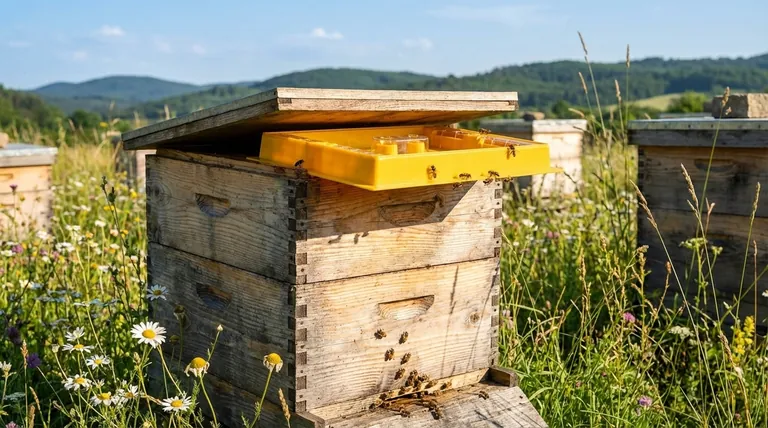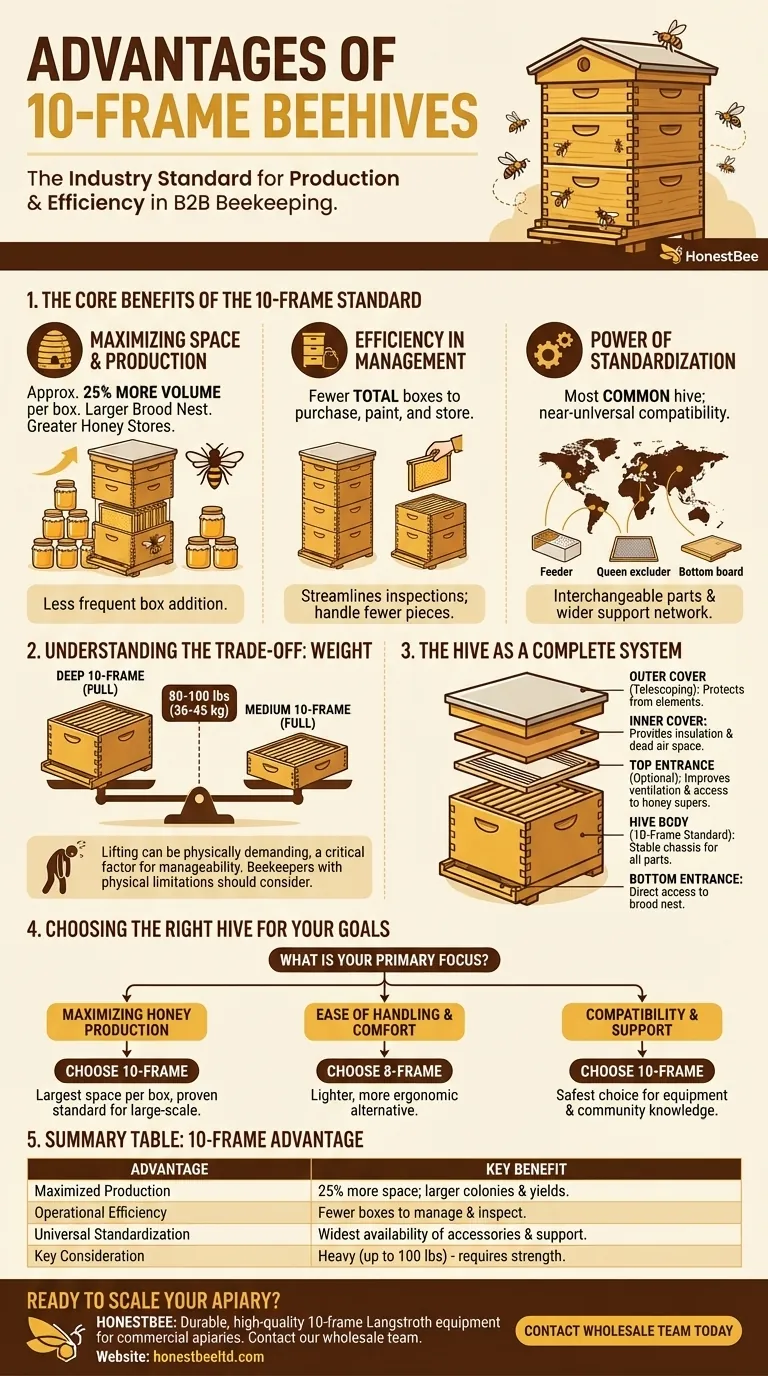From an operational standpoint, the 10-frame Langstroth hive is the established industry standard for several key reasons. It offers more uninterrupted space for the queen to lay and for bees to store honey, which can lead to larger colonies and greater honey yields. Its widespread adoption also means that equipment, accessories, and peer support are more readily available than for any other hive type.
The decision between hive sizes is fundamentally a trade-off. The 10-frame hive is designed for maximum production and efficiency, but this comes at the cost of significant weight, which is a critical factor in manageability.

The Core Benefits of the 10-Frame Standard
The 10-frame hive's dominance is built on a foundation of space, efficiency, and near-universal compatibility. Understanding these pillars is key to appreciating why it remains the go-to choice for commercial operations and many serious hobbyists.
Maximizing Space and Production
A 10-frame hive box is wider than its 8-frame counterpart, providing approximately 25% more volume.
This additional space allows a colony to expand its brood nest (where the queen lays eggs) and honey stores with less frequent need for the beekeeper to add more boxes. For those focused on honey production, this larger capacity per box is a distinct advantage.
Efficiency in Management
While it may seem counterintuitive, having more frames per box can streamline inspections and reduce costs, especially when managing multiple hives.
You have fewer total boxes to purchase, paint, and store for a hive of a given volume. During inspections, you are handling fewer pieces of equipment, as two 10-frame boxes hold more frames than two 8-frame boxes.
The Power of Standardization
The 10-frame Langstroth is the most common hive in use, particularly in North America. This ubiquity is arguably its single greatest advantage.
Nearly all hive accessories, from feeders and queen excluders to specialized bottom boards and covers, are manufactured for the 10-frame footprint. Parts are interchangeable across most manufacturers, and finding support or borrowing equipment from a fellow beekeeper is far easier.
Understanding the Trade-offs: Weight and Ergonomics
The primary advantage of the 10-frame hive—its size and capacity—is also the source of its single biggest drawback: its weight. This is a non-negotiable factor that every beekeeper must consider.
The Physical Cost of Capacity
A deep 10-frame hive body filled with brood, pollen, and honey can weigh 80-100 pounds (36-45 kg). A medium 10-frame super full of honey can weigh 50-60 pounds (23-27 kg).
Lifting this weight repeatedly can be physically demanding and is a common reason for beekeeper fatigue and injury. This factor alone has driven the adoption of 8-frame equipment among many hobbyist beekeepers.
Who Should Reconsider the 10-Frame?
Beekeepers with back problems, limited physical strength, or those who anticipate working their hives alone should seriously weigh this disadvantage.
The lighter weight of an 8-frame system (a full deep is closer to 60-70 pounds) can make the difference between an enjoyable hobby and a physically taxing chore.
The Hive as a Complete System
The hive box is the core of the system, but its performance is influenced by other components. The 10-frame standard provides a stable chassis for these integrated parts.
Entrances for Access and Ventilation
A standard bottom entrance gives foragers direct access to the brood nest, which is efficient for raising young.
Adding a top entrance, often integrated into the inner cover, can improve ventilation, reduce congestion at the main entrance, and give bees direct access to honey supers, bypassing the brood chamber.
The Role of Inner and Outer Covers
An inner cover creates a dead air space that provides crucial insulation, helping the colony regulate temperature. It prevents the bees from sealing the main top cover to the hive body, making inspections much easier.
The outer cover, or telescoping cover, is the hive's roof, protecting the colony from rain, sun, and snow. Its compatibility with the standard 10-frame dimension is essential.
Choosing the Right Hive for Your Goals
Your choice of hive equipment should be directly aligned with your personal goals, physical abilities, and the type of beekeeping you wish to practice.
- If your primary focus is maximizing honey production: The 10-frame hive offers the most space per box and is the proven standard for large-scale operations.
- If your primary focus is ease of handling and physical comfort: The 8-frame hive is a lighter, more ergonomic alternative that is often better suited for hobbyists or those with physical limitations.
- If your primary focus is compatibility and finding support: The 10-frame hive is the safest choice, guaranteeing access to the widest range of equipment and community knowledge.
Ultimately, the best hive is the one you can manage safely, effectively, and consistently throughout the season.
Summary Table:
| Advantage | Key Benefit |
|---|---|
| Maximized Production | 25% more space per box for larger colonies and greater honey yields. |
| Operational Efficiency | Fewer boxes to manage, reducing equipment costs and inspection time. |
| Universal Standardization | Widest availability of compatible accessories and peer support. |
| Key Consideration | Full boxes are heavy (up to 100 lbs), requiring physical strength to manage. |
Ready to Scale Your Apiary with the Industry Standard?
As a leading wholesale supplier to commercial apiaries and equipment distributors, HONESTBEE provides the durable, high-quality 10-frame Langstroth equipment your operation depends on. We understand the demands of production-focused beekeeping.
Let us equip you for maximum efficiency and yield. Contact our wholesale team today to discuss your needs.
Visual Guide

Related Products
- Professional Hive Top Bee Feeder for Beekeeping
- HONESTBEE Professional Hive Top Bee Feeder Feeding Solution
- Commercial 48-Frame Stainless Steel Honey Extractor
- Professional Grade Foldable Beehive Handles
- Professional Galvanized Hive Strap with Secure Locking Buckle for Beekeeping
People Also Ask
- Do I need an inner cover with a hive top feeder? Optimize Your Hive Setup for Healthy Bees
- How to use a top feeder in a beehive? A Guide to Effective Beehive Feeding
- What is a top feeder for bees? Maximize Colony Health with Efficient Feeding
- What types of hive boxes is the round hive top feeder compatible with? Universal Fit for 8 & 10-Frame Langstroth Hives
- What are the features of top feeders for bees? Maximize Hive Health with Safe, High-Capacity Feeding



















